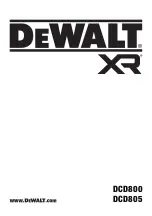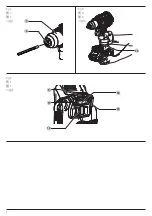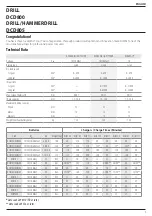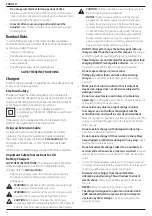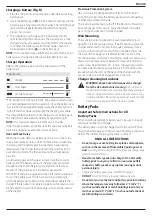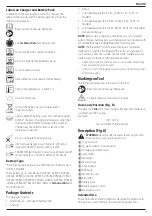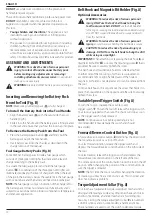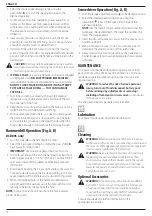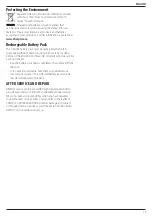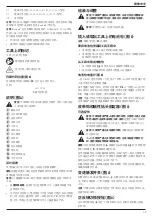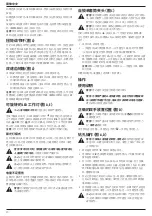
6
English
•
Do not operate this tool for long periods of time.
Vibration caused by hammer action may be harmful to your
hands and arms. Use gloves to provide extra cushion and limit
exposure by taking frequent rest periods.
•
Air vents often cover moving parts and should be
avoided.
Loose clothes, jewellery or long hair can be caught
in moving parts.
Residual Risks
In spite of the application of the relevant safety regulations
and the implementation of safety devices, certain residual risks
cannot be avoided. These are:
• Impairment of hearing.
• Risk of personal injury due to flying particles.
• Risk of burns due to accessories becoming hot
during operation.
• Risk of personal injury due to prolonged use.
SAVE THESE INSTRUCTIONS
Chargers
D
e
WALT
chargers require no adjustment and are designed to be
as easy as possible to operate.
Electrical Safety
The electric motor has been designed for one voltage only.
Always check that the battery pack voltage corresponds to the
voltage on the rating plate. Also make sure that the voltage of
your charger corresponds to that of your mains.
i
Your
D
e
WALT
charger is double insulated in
accordance with IEC60335; therefore no earth wire
is required.
If the supply cord is damaged, it must be replaced only by
D
e
WALT
or an authorised service organisation.
Using an Extension Cable
An extension cord should not be used unless absolutely
necessary. Use an approved extension cable suitable for
the power input of your charger (see
Technical Data
). The
minimum conductor size is 1 mm
2
; the maximum length
is 30 m.
When using a cable reel, always unwind the cable completely.
Important Safety Instructions for All
Battery Chargers
SAVE THESE INSTRUCTIONS:
This manual contains important
safety and operating instructions for compatible battery
chargers (refer to
Technical Data
).
• Before using charger, read all instructions and cautionary
markings on charger, battery pack, and product using
battery pack.
WARNING:
Shock hazard. Do not allow any liquid to get
inside charger. Electric shock may result.
WARNING:
We recommend the use of a residual current
device with a residual current rating of 30mA or less.
CAUTION:
Burn hazard. To reduce the risk of injury,
charge only
D
e
WALT
rechargeable batteries. Other types of
batteries may burst causing personal injury and damage.
CAUTION:
Children should be supervised to ensure that
they do not play with the appliance.
NOTICE:
Under certain conditions, with the charger
plugged into the power supply, the exposed charging
contacts inside the charger can be shorted by foreign
material. Foreign materials of a conductive nature such
as, but not limited to, steel wool, aluminum foil or any
buildup of metallic particles should be kept away from
charger cavities. Always unplug the charger from the
power supply when there is no battery pack in the cavity.
Unplug charger before attempting to clean.
•
DO NOT attempt to charge the battery pack with any
chargers other than the ones in this manual.
The charger
and battery pack are specifically designed to work together.
•
These chargers are not intended for any uses other than
charging
D
e
WALT
rechargeable batteries.
Any other uses
may result in risk of fire, electric shock or electrocution.
•
Do not expose charger to rain or snow.
•
Pull by plug rather than cord when disconnecting
charger.
This will reduce risk of damage to electric plug
and cord.
•
Make sure that cord is located so that it will not be
stepped on, tripped over, or otherwise subjected to
damage or stress.
•
Do not use an extension cord unless it is absolutely
necessary.
Use of improper extension cord could result in risk
of fire,electric shock, or electrocution.
•
Do not place any object on top of charger or place
the charger on a soft surface that might block the
ventilation slots and result in excessive internal heat.
Place the charger in a position away from any heat source. The
charger is ventilated through slots in the top and the bottom
of the housing.
•
Do not operate charger with damaged cord or plug—
have them replaced immediately.
•
Do not operate charger if it has received a sharp blow,
been dropped, or otherwise damaged in any way.
Take it
to an authorised service centre.
•
Do not disassemble charger; take it to an authorised
service centre when service or repair is required.
Incorrect
reassembly may result in a risk of electric shock, electrocution
or fire.
• In case of damaged power supply cord, the supply cord must
be replaced immediately by the manufacturer, its service agent
or similar qualified person to prevent any hazard.
•
Disconnect the charger from the outlet before
attempting any cleaning. This will reduce the risk of
electric shock.
Removing the battery pack will not reduce
this risk.
•
NEVER
attempt to connect two chargers together.
•
The charger is designed to operate on standard 220‑
240V household electrical power. Do not attempt to
use it on any other voltage.
This does not apply to the
vehicular charger.

